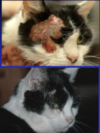Intro to Derm (Marsella) Flashcards
Important aspects of patient history
- Onset
- Length of time of disease
- Seasonality
- Relatives
- Zoonosis
- Environment
- Health status (med hx)
- Life style
- Diet
Primary lesions
- Macule
- Papule
- Plaque
- Pustule
- Vesicle
- Bulla
- Nodule
- Wheal
- Tumor
Macule
Area of skin altered in color, but NOT elevated (patch if > 1 cm diameter)
(primary lesion)

Papule
Solid, raised lesion that has distinct borders (< 1 cm in diameter)
(primary lesion)

Plaque
Elevated lesion w/ flattened top (> 10mm in size)
(primary lesion)

Pustule
Elevations filled w/ pus. Folicular or non-follicular.
(Primary lesion)

Follicular vs. Non-follicular pustules
- Neutrophils
- Eosinophils
- +/- acantholytic cells
- +/- bacteria
Vesicles
Small, clear fluid-filled blisters (< 1mm diameter)
(Primary lesion)

Pustules common with?
Bacterial infections and other inflammatory skin diseases
Vesicles seen with?
Acute contact dermatitis and some autoimmune diseases
Bulla
Clear fluid-filled blister (> 10mm diameter)
(Primary lesion)

Nodule
Firm lesions that extend into the dermis or subcutaneous tissue
(Primary lesion)

Tumor
Swelling or enlargement. May be neoplastic.
(primary lesion)

Wheal
AKA hive. Sharply circumscribed skin elevation produced by edema of the superficial dermis.
(Primary lesion)

Wheals common with?
Allergic reactions
Secondary lesions
- Epidermal collarettes
- Scale
- Crust
- Scar
- Ulcer
- Excoriation
- Lichenification
- Hyperpigmentation
- Hyperkeratosis
Epidermal collarettes
A circular lesion with a circular rim of scale and/or peeling edge. Developed from pastules.
(secondary lesion)

Scale
Flake of abnormal or compacted epithelial cells
(secondary lesion)

Crust
Dried exudate (containing leukocytes and commonly bacteria)
(secondary lesion)

Scar
Fibrotic area resulting from healing of a wound or lesion
(secondary lesion)

Scarring typically associated with?
Alopecia, depigmentation, and/or thinner dermis
Ulcer
Loss of substance on a cutaneous surface exposing inner layers of tissues. May imply full thickness loss of tissue.
(secondary lesion)

Excoriations
Superficial erosion (usually from scratching or abrasion)
(secondary lesion)

Lichenification
Thickening of the skin secondary to chronic trauma/inflammation.
(secondary lesion)

Hyperpigmentation
Increased pigmentation. Commonly seen w/ lichenification.
(secondary lesion)

Hyperkeratosis
Thickening of the stratum corneum due to incr. number of keratinized cells.
(secondary lesion)

Depigmentation
Loss of pigmentation

Typical causes of depigmentation?
Inflammation/neoplastic processes affecting the basement membrane
Cytology (use, sample collection methods)
Useful to diagnose secondary infections
- Skin - tape, swab
- Ear - swab
- FNA of masses
Superficial skin scrapings
Apply mineral oil, scrape up to stratum corneum (no blood)
Deep skin scrapings
Scrape until you get capillary oozing, pinch, scrape, pinch, scrape
Fungal culture
Collect hair on edges of lesions. Can use DTM (dermatophyte test media).
Intradermal skin testing
Inject small amounts of very dilute preparation of antigens intradermally.
Read dog’s response to injected antigen 15-30min later. Compare to negative (saline dilutent) and positive (histamine phostphate) controls.
Alopecia
Decrease in amount, or absence, of hair
Comedo (comedones)
Accumulation of keratin and dried sebum in hair follicle.
Layers of the epidermis
From outward in:
- Stratum corneum
- Stratum lucidum
- Stratum granulosum
- Stratum spinosum
- Stratum basale
Erythema
Redness produced by capillary congestion
Folliculitis
Inflammation of hair follicles and associated adnexae
Keratinocyte
Cell of the epidermis
Seborrhea
Functional distrubance of sebaceous glands or of lipid metabolism of the epidermis. Accompanied by abnormal keratinization.


